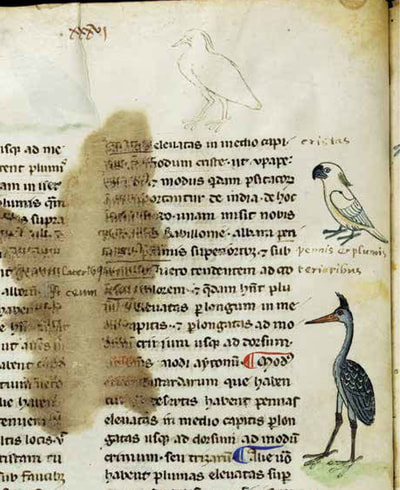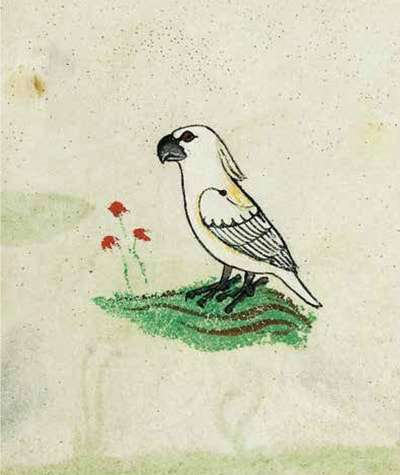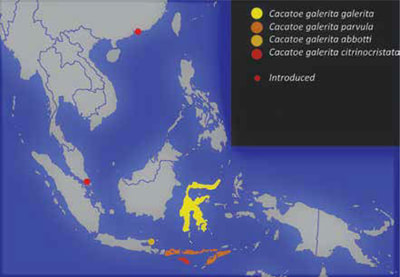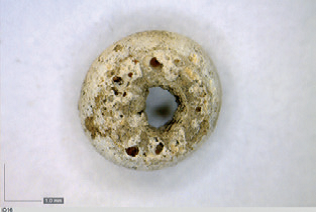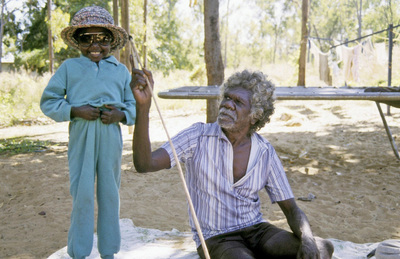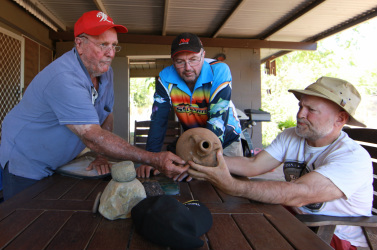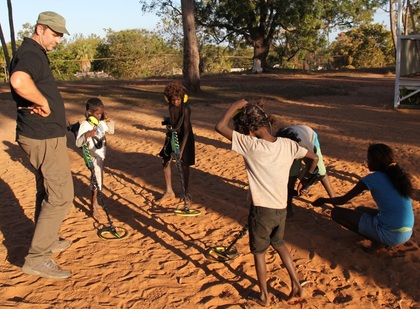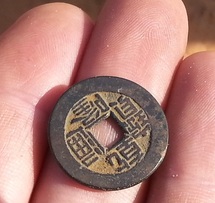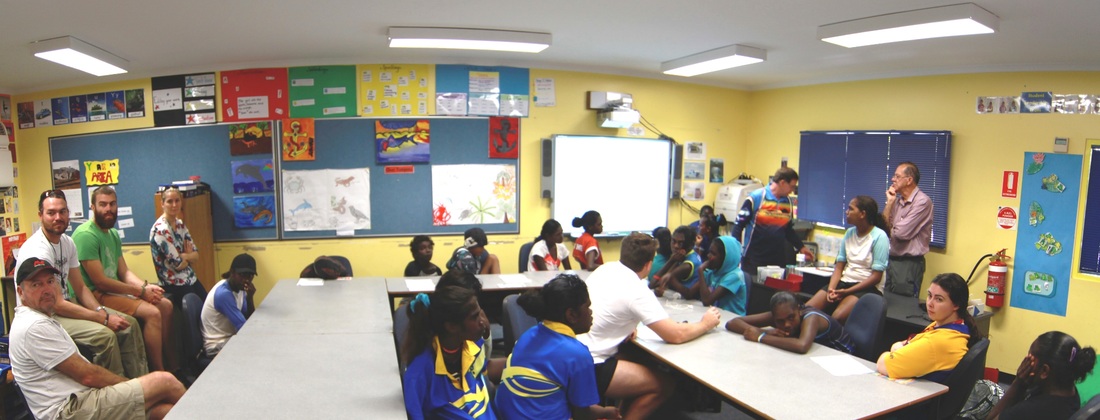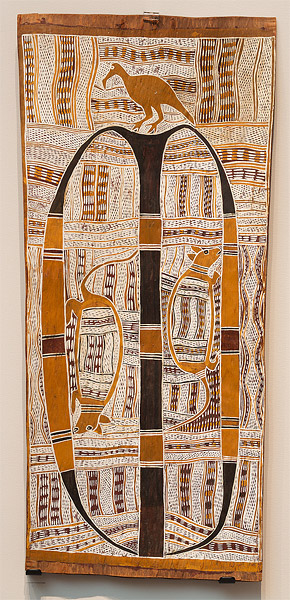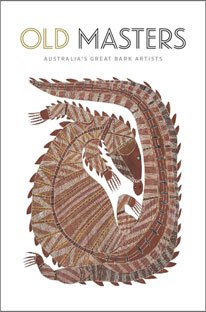LATEST NEWS
'The Lande of Java' was recently published in the Journal of the Australian and New Zealand Map Society Inc. This important paper demonstrates, for the first time, that a significant portion of the Australian landmass was mapped by the Portuguese - long before Dutch & British cartographers. Brian Lees & Shawn Laffan are internationally recognised authorities on cartography and geographic information systems (GIS). Lees' paper 'Radiocarbon', with Annemarie Clements, on the climatic implications of chenier dates in Northern Australia is also appended below.
'THE LANDE OF JAVA’ ON THE JEAN ROTZ MAPPA MUNDI
Brian Lees & Shawn Laffan
Abstract. Using the latitudes and longitudes explicit on the 1542 Jean Rotz ‘Mappa Mundi’, the projection used by Rotz was analysed. It was found to be an Equatorial Stereographic of a type pr obably designed by Rotz. Using this, a modern coastline was projected and then overlaid on the Mappa Mundi using a Geographical Information System. This shows t hat ‘The Lande of Java’ on this map is not offset from the location of modern Australia as is sometimes suggested. The Mappa Mundi in Jean Rotz’s atlas is a good ‘first approximation’ of the Australian continent. The continent is located in the right place, the width of the continent is greater but is of the right order of magnitude, the gross morphology of the east coast is correct, and the southern latitudinal extent of the west coast is correct. The southeastward extension of the east coast may reflect early knowledge of New Zealand.
INTRODUCTION. The Mapping Our World exhibition of early maps held at the National Library of Australia over the summer of 2013-14 provided a setting for some interesting discussions. One seminar (10 November 2013), in which a panel debated ‘The Dieppe Maps Controversy’, was striking for the high level of disagreement amongst the panellists. Some of the strongest opponents of the argument that these represent the oldest surviving maps of Australia seemed to conflate two separate issues (W.A.R. Richardson, 2008). The first: do portions of these maps represent Australia? The second: who might have produced the original fragment from which this is drawn? The first of these is the focus of this paper.
|
| ||||||||||||
All 4 Adventure - Series 10 Episode 5
Catch up with the first instalment featuring our 2018 trip to the Wessel Islands.
Cockatoo Controversy
| |||||||
This paper considers the possible trade links that could have transported a presumably live parrot from Australasia to Europe in the 13th century and so illuminates the complex and extensive networks that have existed to our immediate north during the last 1000 years. Fig. 5 shows the female Triton Cockatoo which the authors favour as the likely candidate for Frederick II's bird- Fig. 6 & 7 show it's native PNG range & distribution.
 Fig 5. Female Triton Cockatoo (C. galleria triton) Trobriand Islands,
Kiriwina, PNG 2009
Fig 5. Female Triton Cockatoo (C. galleria triton) Trobriand Islands,
Kiriwina, PNG 2009
IV. Conclusion
The cockatoo in Frederick II’s De arte suggests more than the fact an Australasian parrot reached Europe in the middle of the thirteenth century: it throws a light on what Amitav Ghosh calls one of ‘those small, indistinguishable, intertwined histories’ that crossed religious lines and was ‘partitioned long ago’.81 Although lands east of the Wallace Line are today considered to have been the very last to have been discovered, this Eurocentric view is being increasingly challenged. Moreover, the case is being made that while India, China, and the Arab world had a strong influence on maritime Southeast Asia, historiography has tended to emphasize the role of outsiders, thus downplaying the maritime achievements of indigenous Southeast Asians.82 In the thirteenth century, just as in the fifteenth when Mantegna painted his cockatoo, Europe lay on the periphery of the complex trading network that originated in the Afro-Eurasian world-system, with Asia being the source of luxury goods. Sultan al-Kamil may not have been aware of the exact place cockatoos came from but he would have been aware that they came from the distant Indies, a place drawn into a complex trading web that brought goods by sea and overland from China into trading posts and the cosmopolitan cities in his domain. To al-Kamil, the cockatoo was a rare, sociable and gifted bird from afar—a fitting gift for the Holy Roman Emperor.
The cockatoo in Frederick II’s De arte suggests more than the fact an Australasian parrot reached Europe in the middle of the thirteenth century: it throws a light on what Amitav Ghosh calls one of ‘those small, indistinguishable, intertwined histories’ that crossed religious lines and was ‘partitioned long ago’.81 Although lands east of the Wallace Line are today considered to have been the very last to have been discovered, this Eurocentric view is being increasingly challenged. Moreover, the case is being made that while India, China, and the Arab world had a strong influence on maritime Southeast Asia, historiography has tended to emphasize the role of outsiders, thus downplaying the maritime achievements of indigenous Southeast Asians.82 In the thirteenth century, just as in the fifteenth when Mantegna painted his cockatoo, Europe lay on the periphery of the complex trading network that originated in the Afro-Eurasian world-system, with Asia being the source of luxury goods. Sultan al-Kamil may not have been aware of the exact place cockatoos came from but he would have been aware that they came from the distant Indies, a place drawn into a complex trading web that brought goods by sea and overland from China into trading posts and the cosmopolitan cities in his domain. To al-Kamil, the cockatoo was a rare, sociable and gifted bird from afar—a fitting gift for the Holy Roman Emperor.
HMAS Patricia Cam 75th Anniversary Events
FRIDAY 19th January 2018 BRISBANE WATER - North of Sydney
Informal get together Friday evening at the Gosford RSL - 26 Central Coast Hwy, West Gosford - adjacent to the Galaxy Motel ($160) & Ashford Motel ($130). 15 minutes’ drive from Davistown.
SATURDAY 20th January 2018 - Heritage Cruise
0900hrs board the ferry at the Davistown Ferry Terminal - depart at 0930. Capacity 120 - 60 inside. Bookings at Central Coast Ferries 0418631313. Parking & drop-off close to the jetty with shade & seating. Tour of Brisbane Water from Cook’s arrival at Broken Bay through the shipbuilding history which includes the Beatties’ Palermo Yard site in Empire Bay - 2 hour duration – $35 inc. morning tea – all proceeds to Pat Cam memorial & signage. Disembark at Davistown Ferry at 1130hrs.
1200hrs – reception & luncheon at the Davistown RSL on Murna Road approx. 0.5Kms from Jetty.
1330hrs - a 15 minutes’ drive to the Palermo Yard unveil a plaque commemorating the Patricia Cam. Short speeches, shade, seating & light refreshment. Duration 1 hour to end at c1500hrs.
1830hrs - Evening dinner at West Gosford RSL
SUNDAY – 21st January Sydney
Suggested sites around Sydney Harbour:- (1) Naval Heritage Centre Museum on Garden Island where the Pat Cam was fitted out – Ferries leave from No 2 wharf Circular Quay on Sunday every hour 8.57 am, 9.57 am etc. – duration 7 minutes. (2) Take a ferry to Watsons Bay to visit the Gap and have a fish and chip lunch in the park. (3) Cam & Sons base was at Blackwattle Bay near the eastern end of the old Glebe Island swing bridge. Day/Night ODI at SCG starting at 1420hrs.
MONDAY 22nd January – AWM Canberra
1200hrs - Aim to arrive in Canberra around midday – a reception for families to get to know eachother will be arranged - there will be some official meet & greet as well as a look around the War Memorial. A reception after the ceremony is being explored.
1655hrs – Last Post Ceremony begins with the national anthem followed by the piper's lament. Visitors are invited to lay wreaths and floral tributes beside the Pool of Reflection. An individual's story (Percy Cameron) is told, and the Ode is recited by Australian Defence Force personnel. The ceremony ends with the sounding of the Last Post. The ceremony can be watched live on Facebook (https://www.facebook.com/AWMemorial/) – is available at (https://www.youtube.com/c/awmlastpost) on YouTube Channel and may be purchased through AWM Esales ([email protected])
The Crowne Plaza in Canberra ($125) is close to the AWM and may be a venue for a reception & dinner after the Last Post ceremony.
Informal get together Friday evening at the Gosford RSL - 26 Central Coast Hwy, West Gosford - adjacent to the Galaxy Motel ($160) & Ashford Motel ($130). 15 minutes’ drive from Davistown.
SATURDAY 20th January 2018 - Heritage Cruise
0900hrs board the ferry at the Davistown Ferry Terminal - depart at 0930. Capacity 120 - 60 inside. Bookings at Central Coast Ferries 0418631313. Parking & drop-off close to the jetty with shade & seating. Tour of Brisbane Water from Cook’s arrival at Broken Bay through the shipbuilding history which includes the Beatties’ Palermo Yard site in Empire Bay - 2 hour duration – $35 inc. morning tea – all proceeds to Pat Cam memorial & signage. Disembark at Davistown Ferry at 1130hrs.
1200hrs – reception & luncheon at the Davistown RSL on Murna Road approx. 0.5Kms from Jetty.
1330hrs - a 15 minutes’ drive to the Palermo Yard unveil a plaque commemorating the Patricia Cam. Short speeches, shade, seating & light refreshment. Duration 1 hour to end at c1500hrs.
1830hrs - Evening dinner at West Gosford RSL
SUNDAY – 21st January Sydney
Suggested sites around Sydney Harbour:- (1) Naval Heritage Centre Museum on Garden Island where the Pat Cam was fitted out – Ferries leave from No 2 wharf Circular Quay on Sunday every hour 8.57 am, 9.57 am etc. – duration 7 minutes. (2) Take a ferry to Watsons Bay to visit the Gap and have a fish and chip lunch in the park. (3) Cam & Sons base was at Blackwattle Bay near the eastern end of the old Glebe Island swing bridge. Day/Night ODI at SCG starting at 1420hrs.
MONDAY 22nd January – AWM Canberra
1200hrs - Aim to arrive in Canberra around midday – a reception for families to get to know eachother will be arranged - there will be some official meet & greet as well as a look around the War Memorial. A reception after the ceremony is being explored.
1655hrs – Last Post Ceremony begins with the national anthem followed by the piper's lament. Visitors are invited to lay wreaths and floral tributes beside the Pool of Reflection. An individual's story (Percy Cameron) is told, and the Ode is recited by Australian Defence Force personnel. The ceremony ends with the sounding of the Last Post. The ceremony can be watched live on Facebook (https://www.facebook.com/AWMemorial/) – is available at (https://www.youtube.com/c/awmlastpost) on YouTube Channel and may be purchased through AWM Esales ([email protected])
The Crowne Plaza in Canberra ($125) is close to the AWM and may be a venue for a reception & dinner after the Last Post ceremony.
First European Child Born in Northern Australia - 27 March 1827
190 years ago, on 27 March 1827, the first white child was born in Northern Australia at Fort Dundas on Melville Island. Elizabeth Melville Richardson’s birth so taxed her mother Jane’s health that she was granted passage & rations to Sydney aboard the Amity – an indulgence cancelled when her lifer husband John was caught selling grog. A feted gardener & botanical collector with Oxley & Mitchell - nobody died of sickness during his tenure at these Garden Point gardens which lasted until the family returned to Sydney in 1829 where John was issued his ticket-of-leave & resumed his post at the Botanical Gardens. In 1854 Elizabeth married Francis Feltis at Bednock Victoria & is yet lost to history. A descendent of John Richardson lives in Darwin today. More on Fort Dundas & John Richardson's long & bottle scarred life http://www.pastmasters.net/fort-dundas--garden-point.html
75th Anniversary of the Rescue of USAF Pilot Clarence 'Sandy' Sanford
75 years ago, on 14 March 1942 a raw 23 year old American Kitty Hawk pilot, Clarence 'Sandy' Sanford, took off from Horn Is. to engage the first Japanese attack on Nth Qld. After inflicting damage on 2 Zeros & suffering damage to himself & his plane - Sanford was disorientated in cloud & began a 1000km jaunt across the Gulf of Carpentaria to parachute into the sea & be rescued from Bremer Is. by 3 Marika men from Yirrkala. He survived through luck, a crucifix & Yolngu bush craft, going on to have a long career as a surgeon. From Cape York to New York was a hell of a journey - Sandy Sanford in gratitude we salute you.
One of Sanford's rescuers lost his life on HMAS Patricia Cam & plaques commemorating these events will be unveiled on 24th April at Yirrkala. More of the story at http://www.pastmasters.net/the-sandy-sanford-story.html - The Sandy Sanford Story under Projects & Activities tab.
One of Sanford's rescuers lost his life on HMAS Patricia Cam & plaques commemorating these events will be unveiled on 24th April at Yirrkala. More of the story at http://www.pastmasters.net/the-sandy-sanford-story.html - The Sandy Sanford Story under Projects & Activities tab.
Past Masters Lecture & Roadshow
 Kids metal detecting on Mission Beach Elcho Island
Kids metal detecting on Mission Beach Elcho Island
Past Masters Lecture: What do the Kilwa Coins, the Boustead Jar and the Doukas Swivel Gun Have in Common?
Where: Theatrette, NT Museum and Art Gallery, Fannie Bay, Darwin.
When: 5.30-7.30pm, Friday July 15, 2016
Suggested donation: $10 adults, students $5, kids free
During WW2, five copper coins from the former Sultanate of Kilwa in East Africa were discovered by Maurice Isenberg on the Wessel Islands, in north-east Arnhem Land, a half a world away from their place of manufacture. In 1998, an earthenware jar was found at Shoal Bay near Darwin by local fisherman Billy Boustead. It is of Spanish or Portuguese origin and upwards of 500 years old. In 2010, young Christopher Doukas from Dundee Beach found an old swivel gun on the mud flats and scientific tests showed that it had laid there for more than 300 years. What do these three discoveries have in common? What do they tell us about Australia’s links to the wider world in the days before Captain Cook? On Friday July 15, 2016 at the Northern Territory Museum and Art Gallery, members of the archaeology and history collective known as the Past Masters will present the group’s findings to date. The latest scientific tests conducted by the team on the Kilwa coins, the Boustead Jar, and the Doukas Swivel Gun (At ANU, the University of Western Australia, and Oxford University) will be shared. There will also be an opportunity to view the artefacts and talk about the ongoing work of the Past Masters.
To promote and encourage the Top End’s fascinating history, on Saturday July 16 the Past Masters will also host an event modelled on the ‘Antiques Roadshow’ where there is an opportunity for Territorians to share historic objects that they have found, bought, or inherited, etc. Distinguished numismatist and Past Master Peter Lane and Territory heritage consultant Mike Owen will play the host for the event which will be held at Dundee Beach. The Past Masters will also be displaying a range of artefacts including 18th century Chinese cash coins similar to the one found at Elcho Island in 2014, convict love tokens, WW2 era boomerangs, and historic seals of Lasseter and Co. etc.
Further Information and to reserve your seats contact [email protected] or [email protected]
Where: Theatrette, NT Museum and Art Gallery, Fannie Bay, Darwin.
When: 5.30-7.30pm, Friday July 15, 2016
Suggested donation: $10 adults, students $5, kids free
During WW2, five copper coins from the former Sultanate of Kilwa in East Africa were discovered by Maurice Isenberg on the Wessel Islands, in north-east Arnhem Land, a half a world away from their place of manufacture. In 1998, an earthenware jar was found at Shoal Bay near Darwin by local fisherman Billy Boustead. It is of Spanish or Portuguese origin and upwards of 500 years old. In 2010, young Christopher Doukas from Dundee Beach found an old swivel gun on the mud flats and scientific tests showed that it had laid there for more than 300 years. What do these three discoveries have in common? What do they tell us about Australia’s links to the wider world in the days before Captain Cook? On Friday July 15, 2016 at the Northern Territory Museum and Art Gallery, members of the archaeology and history collective known as the Past Masters will present the group’s findings to date. The latest scientific tests conducted by the team on the Kilwa coins, the Boustead Jar, and the Doukas Swivel Gun (At ANU, the University of Western Australia, and Oxford University) will be shared. There will also be an opportunity to view the artefacts and talk about the ongoing work of the Past Masters.
To promote and encourage the Top End’s fascinating history, on Saturday July 16 the Past Masters will also host an event modelled on the ‘Antiques Roadshow’ where there is an opportunity for Territorians to share historic objects that they have found, bought, or inherited, etc. Distinguished numismatist and Past Master Peter Lane and Territory heritage consultant Mike Owen will play the host for the event which will be held at Dundee Beach. The Past Masters will also be displaying a range of artefacts including 18th century Chinese cash coins similar to the one found at Elcho Island in 2014, convict love tokens, WW2 era boomerangs, and historic seals of Lasseter and Co. etc.
Further Information and to reserve your seats contact [email protected] or [email protected]
The Eden Ewer
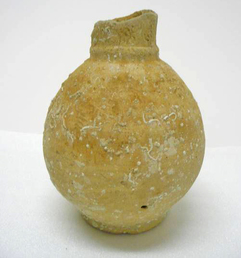 The Eden Urn - trawler bye-catch earthenware.
The Eden Urn - trawler bye-catch earthenware.
The Boustead Jar has been to the TL (thermo-luminescence) laboratory at Jesus College Oxford where Past Master Matt Cupper is overseeing the dating of the fabric of the jar.
Fortunately an Australian graduate student Amber Hood is in the Research Laboratory for Archaeology and the History of Art and is an accomplished practitioner of the dark arts of TL & OSL with interesting publications including work on ceramics available from the link below.
The Eden Urn which was raised in a trawl net near Eden on the south west coast of New South Wales. It is one of a number of curious finds in the area and is currently undergoing XRD (X-ray Diffraction) at ANU under the supervision of Past Master Daryl Wesley.
It is anticipated that preliminary results will be available within a few weeks and these will be presented to the Board of Trustees of the Eden Museum by Daryl & Michael Hermes later in the year.
Fortunately an Australian graduate student Amber Hood is in the Research Laboratory for Archaeology and the History of Art and is an accomplished practitioner of the dark arts of TL & OSL with interesting publications including work on ceramics available from the link below.
The Eden Urn which was raised in a trawl net near Eden on the south west coast of New South Wales. It is one of a number of curious finds in the area and is currently undergoing XRD (X-ray Diffraction) at ANU under the supervision of Past Master Daryl Wesley.
It is anticipated that preliminary results will be available within a few weeks and these will be presented to the Board of Trustees of the Eden Museum by Daryl & Michael Hermes later in the year.
CONGRATULATIONS to Daryl & Mirani for adding to their finds table the prestigious Ulm Ross Award for Best Paper in the Australian Archaeology journal.
‘Small, individually nondescript and easily overlooked’
Contact Beads from Northwest Arnhem Land in an Indigenous-Macassan-European Hybrid Economy.
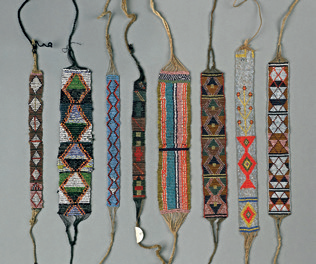
Abstract: This paper examines the interactions between Indigenous traditional owners, Macassan trepangers and European settlers in northwest Arnhem Land, Northern Territory. The recovery of an assemblage of beads from six archaeological sites within the Manganowal estate (Djulirri, Malarrak 1, Malarrak 4, Bald Rock 1, Bald Rock 2 and Bald Rock 3) in the Wellington Range, supports the case for the introduction of these items to Arnhem Land in the pre-Mission era context. We present descriptions of one stone and 28 glass beads/bead fragments and examine the significance of the exchange of these items and how they became incorporated into existing Indigenous cultural systems. This archaeological evidence is assessed in concert with the historical, ethnographic, linguistic and anthropological records. We interpret this within the framework of a hybrid economy between Indigenous people, Europeans and Macassans (Altman 2001, 2006, 2007).
Daryl Wesley and Mirani Litster - Department of Archaeology and Natural History, College of Asia and the Pacific, The Australian National University, Canberra ACT 0200, Australia <[email protected]> <[email protected]>
Daryl Wesley and Mirani Litster - Department of Archaeology and Natural History, College of Asia and the Pacific, The Australian National University, Canberra ACT 0200, Australia <[email protected]> <[email protected]>
| wesley_litster-_venerable_beads_paper_jun_2015.pdf | |
| File Size: | 2888 kb |
| File Type: | |
'Between Two Worlds'
by
Ian S. McIntosh Phd

Venturing deeply into the heart of the Aboriginal
‘Dreaming’, this book connects Burrumarra’s ‘totemic’ philosophy and his
controversial political life. The essays encompass not only the development of
remote indigenous Australian communities, but also the search for Aboriginal
land and sea rights, and the quest for justice and reconciliation. Of
particular interest is how the Yolngu cultural heritage, so influential in
determining the trajectory of intercultural relations, built upon a legacy of
over 200 years of contact with ‘Macassan’ fishermen from Indonesia. These
traders introduced both Islam and the skills of iron-making to Yolngu long
before the arrival of English explorer Captain Cook in Australia in 1770.
In Burrumarra’s recounting of his life, three themes predominated. The first was his desire to achieve a reconciliation of Yolngu and Christian religious beliefs. The second was the attempt to find recognition for Yolngu rights within the wider Australian community. The third theme was his wish for Yolngu to achieve a level of wealth comparable to that of other Australians by taking advantage of the great potential of the land and sea, through fishing, mining and tourism ventures. All three of these ambitions, in their own ways, were controversial, and it was Burrumarra’s intention that their deeper significance be understood and appreciated by a wide audience.
Each chapter of this book therefore brings together illustrative excerpts from Burrumarra’s biography The Whale and the Cross, the volume Aboriginal Reconciliation and the Dreaming, and various articles written for both academic and popular audiences.
The initial focus is on Burrumarra’s philosophy on the need for a treaty between Aborigines and non-Aborigines in Australia. His theory of ‘membership and remembership’ (or adoption of non-Aborigines into the Yolngu realm) as a mechanism for pursuing Yolngu rights on the national stage is discussed. This is followed by a series of biographical essays, and also his thoughts on the ‘totemic embrace’, that special bond that exists between Yolngu and various totemic species for which they have ritual and spiritual authority. Later chapters describe Burrumarra’s role in the extraordinary Adjustment Movement in Arnhem Land of 1957, and also the question of whether treaties were signed between Yolngu and outsiders, in particular the Macassans, in pre-colonial days. The manner in which the Yolngu engaged with the very first outsiders on the coast, including Islamic peoples, and also those with the skills to transform the ‘red rock’ (haematite) of the coast into tools of iron, is highlighted.
In Burrumarra’s recounting of his life, three themes predominated. The first was his desire to achieve a reconciliation of Yolngu and Christian religious beliefs. The second was the attempt to find recognition for Yolngu rights within the wider Australian community. The third theme was his wish for Yolngu to achieve a level of wealth comparable to that of other Australians by taking advantage of the great potential of the land and sea, through fishing, mining and tourism ventures. All three of these ambitions, in their own ways, were controversial, and it was Burrumarra’s intention that their deeper significance be understood and appreciated by a wide audience.
Each chapter of this book therefore brings together illustrative excerpts from Burrumarra’s biography The Whale and the Cross, the volume Aboriginal Reconciliation and the Dreaming, and various articles written for both academic and popular audiences.
The initial focus is on Burrumarra’s philosophy on the need for a treaty between Aborigines and non-Aborigines in Australia. His theory of ‘membership and remembership’ (or adoption of non-Aborigines into the Yolngu realm) as a mechanism for pursuing Yolngu rights on the national stage is discussed. This is followed by a series of biographical essays, and also his thoughts on the ‘totemic embrace’, that special bond that exists between Yolngu and various totemic species for which they have ritual and spiritual authority. Later chapters describe Burrumarra’s role in the extraordinary Adjustment Movement in Arnhem Land of 1957, and also the question of whether treaties were signed between Yolngu and outsiders, in particular the Macassans, in pre-colonial days. The manner in which the Yolngu engaged with the very first outsiders on the coast, including Islamic peoples, and also those with the skills to transform the ‘red rock’ (haematite) of the coast into tools of iron, is highlighted.
 Author Ian McIntosh in the Wessel Islands
Author Ian McIntosh in the Wessel Islands
Australian Anthropologist Dr. Ian S. McIntosh is the
Director of International Partnerships at Indiana University Purdue University Indianapolis
(IUPUI) and Associate Director of the Confucius Institute in Indianapolis. He is the former
Managing Director of Cultural Survival, one of the world’s foremost organizations promoting
the rights, voices and visions of indigenous peoples. His great passion is Aboriginal
Australia where he has worked hand in hand with indigenous peoples in both Queensland and
the Northern Territory, including seven years in north-east Arnhem Land in the 1980s and
1990s. Dr. McIntosh has written two
books and over 100 articles on indigenous themes, and is a co-founder
of Past Masters International, a multidisciplinary team of history and heritage
specialists searching the Indian Ocean for clues relating to the discovery of medieval Kilwa Sultanate
(Tanzania, Africa) coins on the remote and beautiful Wessel Islands of northern Australia.
Dr. McIntosh is also a former Deputy Country Director of the Armenia Tree Project in Yerevan, Republic of Armenia, where he worked on projects to reduce poverty and promote environmental sustainability. In Australia, he has worked as a liaison officer with the Department of Aboriginal and Islanders’ Advancement, as an anthropologist in Kakadu National Park, and as an educator at both Kormilda and Shepherdson Indigenous Colleges. In 2010 he was named a Rotary Peace Fellow at Chulalongkorn University in Thailand for his teaching in the field of justice and human rights. A course that he developed at the Tufts University Experimental College in the 1980s entitled ‘Truth and Reconciliation in Global Perspective’ has been taught in various formats at IUPUI, Cornell College, and the University of Queensland. He and his team at IUPUI have received major national awards, including the Senator Paul Simon Award, and the Heiskell Award, for the building of international educational partnerships and promoting a climate of internationalization.
Dr McIntosh’s recent work in peace-building includes a three year visioning project linking students at IUPUI and Gaza University in a discussion on the preconditions for peace and prosperity in the Middle East. In Kenya, he was a co-organizer of the 2009, 2010, and 2011 peace and reconciliation conferences held in collaboration with Moi University in the wake of the devastating 2007 post-election crisis. In 2013, with wide-ranging sponsorship, he co-organized a unique peace race for the peoples of Eldoret as a necessary step in the healing process. His most recent publications include “The Classroom as Peace Incubator A US-Gaza case study” in Peace and Conflict Studies, “Reconciliation: You’ve Got to be Dreaming” in the Conflict Resolution Quarterly, and “A Creative Approach to Measuring Reconciliation in Rwanda” in Conflict Trends.
Follow the link to order your copy of 'Between Two Worlds'
http://www.amazon.com/Between-Two-Worlds-Aboriginal-Burrumarra/dp/1457536099/ref=sr_1_2?s=books&ie=UTF8&qid=1427993832&sr=1-2&keywords=ian+s+mcintosh
Dr. McIntosh is also a former Deputy Country Director of the Armenia Tree Project in Yerevan, Republic of Armenia, where he worked on projects to reduce poverty and promote environmental sustainability. In Australia, he has worked as a liaison officer with the Department of Aboriginal and Islanders’ Advancement, as an anthropologist in Kakadu National Park, and as an educator at both Kormilda and Shepherdson Indigenous Colleges. In 2010 he was named a Rotary Peace Fellow at Chulalongkorn University in Thailand for his teaching in the field of justice and human rights. A course that he developed at the Tufts University Experimental College in the 1980s entitled ‘Truth and Reconciliation in Global Perspective’ has been taught in various formats at IUPUI, Cornell College, and the University of Queensland. He and his team at IUPUI have received major national awards, including the Senator Paul Simon Award, and the Heiskell Award, for the building of international educational partnerships and promoting a climate of internationalization.
Dr McIntosh’s recent work in peace-building includes a three year visioning project linking students at IUPUI and Gaza University in a discussion on the preconditions for peace and prosperity in the Middle East. In Kenya, he was a co-organizer of the 2009, 2010, and 2011 peace and reconciliation conferences held in collaboration with Moi University in the wake of the devastating 2007 post-election crisis. In 2013, with wide-ranging sponsorship, he co-organized a unique peace race for the peoples of Eldoret as a necessary step in the healing process. His most recent publications include “The Classroom as Peace Incubator A US-Gaza case study” in Peace and Conflict Studies, “Reconciliation: You’ve Got to be Dreaming” in the Conflict Resolution Quarterly, and “A Creative Approach to Measuring Reconciliation in Rwanda” in Conflict Trends.
Follow the link to order your copy of 'Between Two Worlds'
http://www.amazon.com/Between-Two-Worlds-Aboriginal-Burrumarra/dp/1457536099/ref=sr_1_2?s=books&ie=UTF8&qid=1427993832&sr=1-2&keywords=ian+s+mcintosh
The 1871 Undersea Telegraph Cable - Redisovered
What is believed to be the long lost 1871 undersea cable has been found by Mike Owen using a Minelab Excalibur II - the cable was landed here to meet the 2,000 mile Overland Telegraph Line to Adelaide. The cable was anchored at Port Darwin then paid out by the cable ships across the Timor Sea to Banjowanji in east Java - linking Australia to the world. It is in a shallow trench as described at the time and is on the outside (west) of the cable on the surface (1879). This telegraph cabling was the first global infrastructure project and Australia's largest engineering project prior to the Snowy Mountain scheme. Details at Overland Telegraph & Undersea Cables page http://www.pastmasters.org.au/overland-telegraph-amp-undersea-cables.html
2014
The Real Australia Day

Instead of celebrating New South Wales Day when nine ship loads of pimps, prostitutes and pick-pockets arrived at Port Jackson - the National commemoration should perhaps be on the day that Matthew Flinders discovered that Australia was an island continent from observations at Sweers Island in the Gulf of Carpentaria - giving him the naming rights despite the preference of his patron Sir Joseph Banks who, in his dotage, favoured Terra Australis. Strictly, the publication of maps and descriptions validates claims of discovery and that occurred on the 19th July 1814 with the publication of A Voyage to Terra Australis - it was also the day that Matthew Flinders RN died. The bicentenary passed almost unregarded. The nation must be younger - how could it otherwise be so careless of its history?
His last act on Australian soil occurred at Marchinbar Island in the Wessels, in October 1803, in the 29 ton Cumberland - it was to gift axes to some locals who'd wandered down for a chat & diarising them as the "Australians".
A small commemorative effort by the Past Masters will be to attempt to locate those places which feature anonymously in Westall's drawings of East Arnhem Land.
His last act on Australian soil occurred at Marchinbar Island in the Wessels, in October 1803, in the 29 ton Cumberland - it was to gift axes to some locals who'd wandered down for a chat & diarising them as the "Australians".
A small commemorative effort by the Past Masters will be to attempt to locate those places which feature anonymously in Westall's drawings of East Arnhem Land.
The Loss of HMAS Patricia Cam
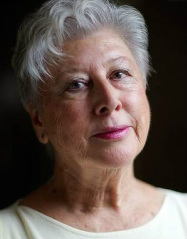
"Without the Past Masters my father's story would still be a no-go zone"
Jan Braund - daughter of Percival J Cameron whose grave and that of Gitjbapuy Marrkulu have been located by the Past Masters on Garurra Island, in the Wessels Islands chain, some 400 miles EEN of Darwin in Australia's Northern Territory. The Navy has maintained that Percy Cameron was "Lost at Sea" despite first hand testimony at the Board of Inquiry and subsequent publishing of "Trying to be Sailors" by John Leggoe which details the entire affair.
A simple error of letting the clocks run down by Matthew Flinders' brother Samuel in 1803 led to the charts being approximations and that calculating the Lat & Long from the 1940 chart led to the wrong beach being identified some 1.5 miles due south of the actual landing place. However, no record of attempted retrieval has been found & ADF has always claimed they were lost at sea. Incompetence or cover-up, either way it has caused a lifetime of mental cruelty.
The link to the 'I want him home' article http://www.theage.com.au/national/i-want-him-home-20140310-34g7k.html
Jan Braund - daughter of Percival J Cameron whose grave and that of Gitjbapuy Marrkulu have been located by the Past Masters on Garurra Island, in the Wessels Islands chain, some 400 miles EEN of Darwin in Australia's Northern Territory. The Navy has maintained that Percy Cameron was "Lost at Sea" despite first hand testimony at the Board of Inquiry and subsequent publishing of "Trying to be Sailors" by John Leggoe which details the entire affair.
A simple error of letting the clocks run down by Matthew Flinders' brother Samuel in 1803 led to the charts being approximations and that calculating the Lat & Long from the 1940 chart led to the wrong beach being identified some 1.5 miles due south of the actual landing place. However, no record of attempted retrieval has been found & ADF has always claimed they were lost at sea. Incompetence or cover-up, either way it has caused a lifetime of mental cruelty.
The link to the 'I want him home' article http://www.theage.com.au/national/i-want-him-home-20140310-34g7k.html

"I am most grateful for the work done by Past Masters in tracing evidence that has emerged on the Pat Cam's wartime fate, from which my father was captured."
Rev. Noel Kentish - eldest son of Rev. Leonard Noel Kentish who is the only Australian ever to be taken prisoner of war from Australian home territory. His subsequent beheading was a war crime for which Sagejima Mangan was executed at Stanley Prison, Hong Kong.
Rev. Noel Kentish - eldest son of Rev. Leonard Noel Kentish who is the only Australian ever to be taken prisoner of war from Australian home territory. His subsequent beheading was a war crime for which Sagejima Mangan was executed at Stanley Prison, Hong Kong.

Paddy Babawun Marangu (1906-??), lugger master of Milingimbi was a survivor of the sinking of the Pat Cam. He lit the fire that raised their spirits and summoned the Yolngu from across the Cumberland Strait. John Leggoe wrote "The raft grounded on the sand, we carried the wounded up the beach and then dragged the raft above high water mark. As I turned round to take stock of our surroundings a fire blazed up from a natural fireplace. Paddy and his mate (Narritjin) had got the fire going by primitive methods within minutes of our landing." The family at Mili is being contacted so that they can follow the unfolding story.This NT Library image {PH0127/0510} was taken in 1962 by Sr. Ellen Kettle. This view is reversed as it is a morning shot underneath the Tamarinds with the store shed at the top of the barge landing & the Arts Centre behind that.

One of the 3 Yolngu from Yirrkala Mission - sent to Elcho Is. by Thornell on a 200 mile canoe trip to check the mail - Narritjin Maymuru became a renowned artist. The Old Masters exhibition of bark paintings at the National Gallery is displaying 14 barks by Narritjin which respect the Djarrakpi homeland country - it is a Laynhapuy Homeland on Grindall Point at the top of Blue Mud Bay.
There are more than 20 pieces of Narritjin's work in the collection of the Museum & Art Gallery of the NT in Darwin. Narritjin was on board the Pat Cam when she was bombed on 22 February 1943 - he was also a member of the team that brought in Tuckiar - famed killer of Constable Albert McColl on Woodah Island in 1933. http://www.nma.gov.au/exhibitions/old_masters/home
There are more than 20 pieces of Narritjin's work in the collection of the Museum & Art Gallery of the NT in Darwin. Narritjin was on board the Pat Cam when she was bombed on 22 February 1943 - he was also a member of the team that brought in Tuckiar - famed killer of Constable Albert McColl on Woodah Island in 1933. http://www.nma.gov.au/exhibitions/old_masters/home
Narritjin Maymuru, a survivor of the HMAS Patricia Cam disaster was a famous artist - his barks respect the Djarrakpi homeland country which is a Laynhapuy Homeland on Grindall Point at the top of Blue Mud Bay.





